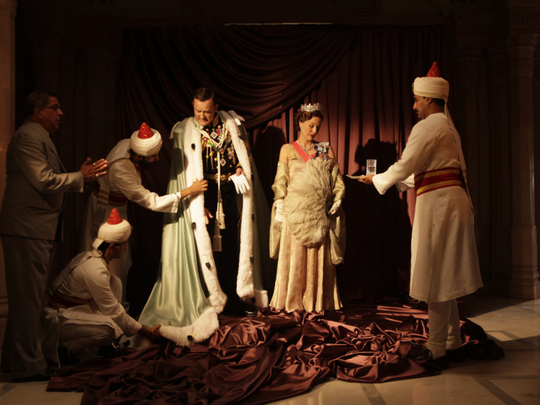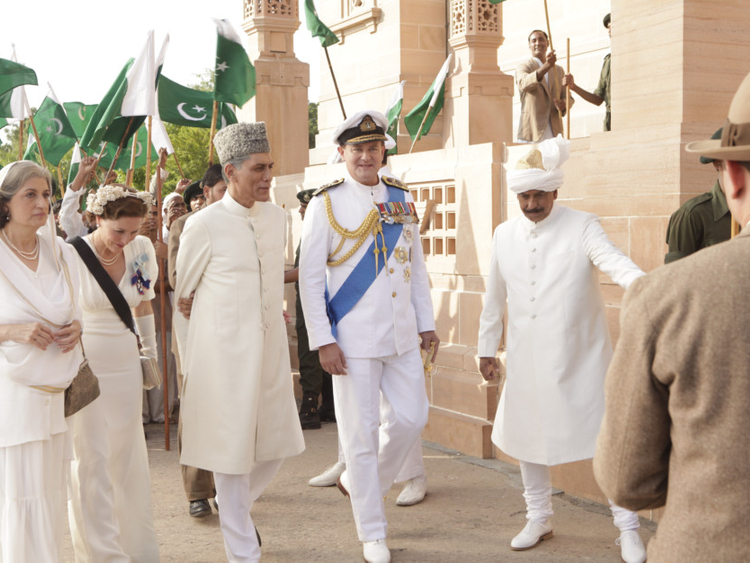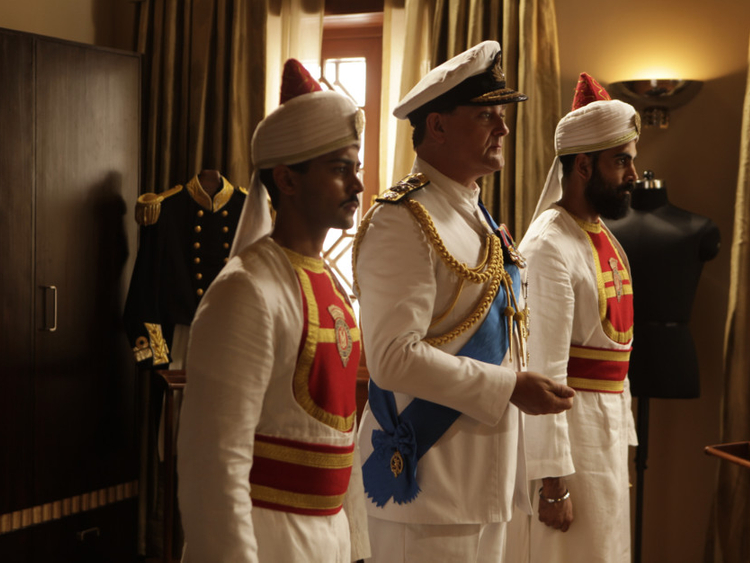
Gurinder Chadha’s Raj film Viceroy’s House begins with an ominous warning: “History is written by the victors.” It sure is. The empire and its descendants have their fingerprints all over this story.
Viceroy’s House, the story of the Mountbattens’ arrival in India and the subcontinent’s subsequent breakup, opens to the sight of bowing, preening and scraping Indians at work on the lawns, carpets and marble floors that are to greet the last viceroy of colonised India, Lord Louis Mountbatten — or Dickie, as he was known — played by the rosy Hugh Bonneville. In one of his first scenes, Mountbatten instructs his Indian valets that he never wants to spend more than two minutes getting dressed — fitting for the man who dismembered India in less than six weeks. As always, it is the Indians, not the British, who fail in the simplest of tasks set out for them (they take 13 minutes).
The benevolence of the Mountbattens and, by association, the British Raj is laced throughout Chanda’s film. The Second World War, we are told at the start by another pair of Indian valets, has exhausted the British and that is why they have “announced” they will be leaving India. There is no mention of the freedom struggle, Gandhian civil disobedience and resistance that brought the empire to its knees without firing a shot. Nor of the persecution and imprisonment of India’s independence leaders, successful economic boycotts of the industrialised British behemoth or the savagery and theft of imperialism (at least three million Indians died in the Bengal famine, a man-made disaster). It is simply that the British were “exhausted” — and that, too, by the Germans.
Jeet Kumar (Manish Dayal), our resident Hindu valet — because Viceroy’s House is cognisant of India’s multiculturalism only in the way that census-takers and bureaucrats are, one Hindu, one Sikh, one Muslim, counting each group so they may assess their value as well as their threats — has arrived at the viceroy’s house from his former job as a police officer. He wastes no time in announcing: “Mountbatten sahib is a heroic man, he has freed Burma, and now he’s coming to free India.” Freedom is not something fought and won by Indians; it is a gift from the Mountbattens and the empire they represent.
At the same moment, the Mountbattens are descending through the clouds as Dickie looks out of an aeroplane window and bemoans the task ahead of him. “You’re giving a nation back to its people,” his daughter Pamela reminds him, as though India had been colonised by some other, alien force those past 300 years.
This theme is repeated throughout Chadha’s elegy to her former colonisers. “We have come to give India its freedom, not to tear her apart,” whispers Edwina Mountbatten (Gillian Anderson). As though it were the Nazis or the Ottomans who had held India and its people captive, subordinating their will and their liberty, for all these centuries. “How can it be getting worse under us?” Edwina asks, in a distress that would be genuine but for the insidious message cloaked behind every line in this unctuous and craven film: India’s suffering is India’s fault.
India’s revolutionaries and leaders are portrayed with a comic disrespect. Not once can they be counted on to hold a civilised conversation with each other (or even turn up to the same meetings) and are, in turn, sneering, smug and silly. Mountbatten spends the entirety of this film lecturing and condescending to finer men than he. Jawaharlal Nehru, India’s finest orator and architect of the modern Indian state, is continually patronised by Mountbatten — who reminds every Indian leader he comes across that they went to Cambridge and that made them clever and Cambridge is in fact English, so thank you Great Britain.
It would be criminal to compare the two men’s intellect or vision, but it is always with a downward gaze that the subaltern is rendered in Viceroy’s House. Muhammad Ali Jinnah (Denzil Smith), the founding father of Pakistan, is scolded by the viceroy every time he turns up at his house and even Mahatma Gandhi — who, with rotten teeth is depicted like some mad old uncle — smilingly feeds the Mountbattens goat curd the first time they meet, as though that is the extent of his meditations at the time.
Communal violence
Britain gave us railroads, their language and cutlery (these people eat with their hands, Lady Mountbatten is warned as she announces her desire to entertain native guests at Viceroy’s House, the couple’s official residence). We would be mindful, as Chadha studiously is, to ignore the bloodletting.
Communal violence between Hindus and Muslims is spoken of by the Mountbattens and other Raj imperialists as though it were a cyclone, arriving in India from some unknown provenance, moved by an unknowable science. Divide and rule, a staple of British colonial administration, is given no credence. Three hundred million Hindus and Sikhs want a united India, Lady Mountbatten informs us via Raj interlocutors; it is 100 million Muslims who do not. Mirroring the fractures of modern nationalism wrought by India’s partition, Chadha seems to take pleasure in laying the bloodshed and brutality of 1947 at the feet of two particular villains: Muslims and Jinnah.
Jinnah is at his Bela Lugosi finest, dark circles around his eyes and his silver hair roguishly slicked back. To divide India is a tragedy, Mountbatten sighs, how can we convince Jinnah not to? Well, according to Chadha, you can’t. Jinnah, a successful barrister and leader of the Muslim League, is simply introduced to us as a “trouble maker”. The American ambassador, Mountbatten, Cyril Radcliffe (the man who drew up the new borders between India and Pakistan), every rotund and sweating Englishman lays the onus of partition at Jinnah’s feet, as though centuries of colonialism had been peaceful and joyful and British rule had not been built on a systematic and brutal communalism designed to pit brother violently against brother.
Not once do you witness any violence on behalf of India’s foreign rulers; they are serene and encouraging, weighed down with the heavy burden of soothing these wild, intemperate people. The valets, cooks and servants of Viceroy’s House can be counted on to turn viciously against each other, so much so that Mountbatten must convene a meeting. “No violence is tolerated in Viceroy’s House,” he reprimands the barbaric natives. By this point in the film, sadly, the audience cannot count on the director — or scriptwriters — to inform us that the very foundations of the viceroy’s residence were built on violence. The only Indians in this film are servants — or politicians — as though no other kind of subaltern existed. Chadha imagines this an innovation and has called Viceroy’s House the “Upstairs, Downstairs” of partition, as though there has ever been any other kind of Raj film. However, even Richard Attenborough’s Gandhi depicted the injustice, savagery and shame of the Raj more honestly than Chadha dares.
All the riots in Chadha’s film seem to be caused by Muslims. Riots in the Punjab interrupt the Mountbattens at a party and, though the disruption is delivered breathlessly, there is still time to announce that they have been carried out by Muslims. Dilip, a Sikh valet who spends the whole film fighting his countrymen instead of his occupiers, leaves to check on his village in the Punjab, only to return dusty and dishevelled. It’s gone, all of it burned to the ground by Muslims who, in this film, are always the perpetrators of violence, never its victims.
We have some brushes with symmetry regarding the violence that Muslims, like Hindus and Sikhs, also suffered, but they are all false alarms. Jeet’s love interest is Aalia (Huma Qureshi), a Muslim, and as they walk to her servants’ quarters one evening they find it set ablaze. Aalia’s home is filled with smoke and her blind father — played by the late Om Puri — isn’t there. Aalia is distraught and we, too, are gripped with fear. But don’t worry. Her father didn’t die; he’s just sitting at a neighbour’s house. No harm, no foul.
Pakistan is a place so nasty it even destroys Aalia and Jeet’s love when she is forced to migrate there (not even her strapping fiance can thwart Jeet and her romance the way my country can). Towards the end of the film, Jeet is told that Aalia’s train has not made it to Lahore — Chadha’s begrudging mention of the ghost trains that left stations filled with migrants only to arrive at their destination filled with corpses. He has a bit of a cry, but, again, no need to worry. Aalia is alive. Muslims don’t die in Viceroy’s House. They are too busy killing, even their own.
Crude moment
Amid the chaos of partition, Chadha shows a kindly elder Sikh lady who has brought a Muslim woman to the police. The Muslim woman is black and blue. Her father, the old woman tells the cop, threw her under a train, but she would like to adopt her. The crudeness of this moment is painful and sad to behold. Even a (pointedly non-Muslim) stranger is more nurturing than a Muslim parent.
Chadha, who describes herself as a British Indian filmmaker, was born in Kenya, but her family originally hail from Rawalpindi and Jhelum in what became Pakistan. Speaking in London ahead of the film’s release, Chadha described these cities as ending up on the “wrong side” after partition. I wasn’t aware there was a right or wrong side.
It is true that India and Pakistan were one people with millennia of history uniting us, but the forces that broke India and divided us are the very ones that Viceroy’s House is at pains to exonerate. “This tragedy is not of your making,” Lady Mountbatten warmly soothes her husband as the couple preside over the destruction of India.
As the fires of 1947 rage, the Mountbattens dress up in khaki kit and busy themselves feeding the fleeing poor (“Feed the children first!” Edwina cries) and breaking up bloody skirmishes between Indians. It was with a deep wound that I watched Chadha depict Jawaharlal Nehru being slapped by a fellow Indian for “breaking the country” while the British, who laid waste to our country, are celebrated for nothing and pardoned for everything.
The lie of this pernicious scene, wilfully ignorant of history if one is generous and purposely defamatory if one is not, points to a sorrowful truth: the psychological damage wrought by colonialism festers deeply among some south Asians.
Viceroy’s House betrays the profound inferiority complex that plagues colonised people, a trauma as severe as the physical assaults and violence done to the land and bodies of subjugated people. It is exactly this kind of thinking that infected those who rioted and murdered their compatriots — a sense of fully absorbing the coloniser’s claims of racial, moral and civilisational superiority. How else to explain the damage to the colonised psyche, whose imagination is so deeply corroded that it can believe that white skins are superior to brown skins, that the British are greater than Indians, that one religion prevails over another? It is in accepting these tragic untruths that nations are crippled with a paralysing fear of others and sincere loathing of the self.
Viceroy’s House is the film of a deeply colonised imagination. Its actors are collateral damage; no ill can be spoken of their talent or their craft. But as a south Asian I watched this film in a dark cinema hall and wept. This August will mark the 70th anniversary of the largest migration in human history. Fifteen million Indians were displaced and more than a million killed as the subcontinent was torn asunder. What value was freedom if it did not empower people to think without chains?
If this servile pantomime of partition is the only story that can be told of our past, then it is a sorry testament to how intensely the empire continues to run in the minds of some today.














